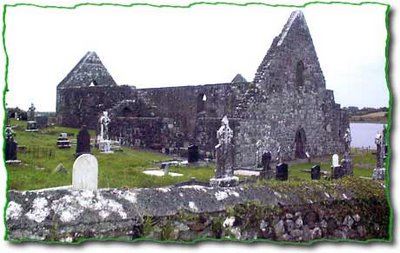Irish Song - Kilkelly, Ireland
I was a wee bit behind in my posts last week, but a wee bit ahead this week - it's all about balance isn't it!
Urlaur Abbey lies three miles from Kilkelly on the banks of Urlaur Lake, a monastic settlement founded in 1430 by the Dominicans
Never heard this song before, but now Kilkelly Ireland is of one of my favorites. (Note: When you click on these YouTube links, you can expand the frame by clicking on the small box underneath and to the far right of the picture.)You can read about this entirely true, and sad story when you click through as well as read the lyrics. The artists singing Irish Famine era song are Mick Maloney, Jimmy Keane with Robbie O'Connell taken from the "Bringing it all Back Home" CD.
In short, here's a quick recap of the story behind the song. an excerpt of the story (check out the visuals - this guy did an awesome job).
Kilkelly (in Irish, Cill Cheallaigh) is a village in Kilmovee parish County Mayo, Ireland. It is just south of Knock International Airport, lying between the Airport and the town of Knock itself. It is a small village, notable due to the song "Kilkelly, Ireland", written by an American who discovered a series of letters between his Irish immigrant ancestor, and that ancestor's father, a schoolmaster in Kilkelly. The song details the events in Kilkelly, with the father repeatedly asking (apparently in vain) for his son to come home for a visit.
The "Kilkelly Ireland Song" is now a famous ballad and it draws its inspiration from a series of ten surviving letters written on behalf of Byran and Elizabeth Hunt by the local school master to their emigrant son in America.
John Hunt emigrated to the States in 1855 and the letters written to him by his parents were re-discovered in an attic in Bethesda Maryland by his American descendants the Jones family. Some 120 years after they were written, Peter Jones a great, great grandson of John Hunt composed the ballad based on the contents of the letters.
It is a poignant song dealing with the effects of Famine, poverty and emigration in one Irish family. However its universal appeal comes from the fact that this could be the saga of countless thousands of other families in the latter part of the 19th century.
The old cemetery mentioned in the song (see picture above) has been renovated and restored, and a picnic area has been developed close by on the banks of the Trimogue.




0 Comments:
Post a Comment
Subscribe to Post Comments [Atom]
<< Home